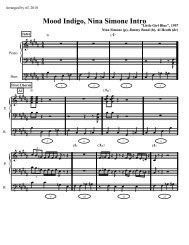Fenchel Duality for Machine Learning, Part II: A Bit More Theory
Fenchel Duality for Machine Learning, Part II: A Bit More Theory
Fenchel Duality for Machine Learning, Part II: A Bit More Theory
You also want an ePaper? Increase the reach of your titles
YUMPU automatically turns print PDFs into web optimized ePapers that Google loves.
<strong>Fenchel</strong> <strong>Duality</strong> <strong>for</strong> <strong>Machine</strong> <strong>Learning</strong>, <strong>Part</strong> <strong>II</strong>:<br />
A <strong>Bit</strong> <strong>More</strong> <strong>Theory</strong><br />
Ryan M. Rifkin<br />
Honda Research Institute USA, Inc.<br />
Human Intention Understanding Group<br />
2007<br />
R. Rifkin <strong>Fenchel</strong> <strong>Duality</strong> <strong>II</strong><br />
honda-logo
Epigraphs<br />
Definition (Epigraph)<br />
Given a function f : R n → [−∞, ∞], the epigraph of f , epi f , is<br />
defined by<br />
epi f = {(y, e) : e ≥ f(y)} ⊂ R n × R.<br />
We say f is closed or convex if epi f is closed or convex. f is<br />
proper when epi f �= ∅ and f > −∞. We call a closed, convex,<br />
proper function a ccp function.<br />
R. Rifkin <strong>Fenchel</strong> <strong>Duality</strong> <strong>II</strong><br />
honda-logo
Functional Minimizers<br />
Definition<br />
Given f : Rn → (−∞, ∞], we define the set argminy∈Rn f(y) as<br />
follows,<br />
argmin<br />
y∈Rn ⎧<br />
⎨ R<br />
f(y) =<br />
⎩<br />
n infy∈Rn f(y) = ∞<br />
{y : f(y) = f0} infy∈Rn f(y) = f0<br />
∅<br />
∈ R,<br />
infy∈Rn f(y) = −∞<br />
with symmetrical definitions <strong>for</strong> argmax when needed.<br />
Even in the second case, argmin y f(y) may still be empty. The<br />
main case of interest is the second case when argmin y f(y) is<br />
not empty.<br />
R. Rifkin <strong>Fenchel</strong> <strong>Duality</strong> <strong>II</strong><br />
honda-logo
Subgradients<br />
Definition (subgradients and subdifferentials)<br />
If f : R n → (−∞, ∞] is convex and y ∈ dom f , then φ ∈ R n is a<br />
subgradient of f at y iff it satisfies φ t z ≤ f(y + z) − f(y) <strong>for</strong> all<br />
z ∈ R n . The set of all such φ is the subdifferential and denoted<br />
∂f(y). By convention, ∂f(y) = ∅ if y /∈ dom f .<br />
Subgradient generalizes the notion of gradient: if f is<br />
differentiable, then ∂f(y) contains a single point, the gradient.<br />
R. Rifkin <strong>Fenchel</strong> <strong>Duality</strong> <strong>II</strong><br />
honda-logo
<strong>Fenchel</strong>-Legendre Conjugate<br />
Definition (<strong>Fenchel</strong>-Legendre conjugate)<br />
Given a function f : R n → (−∞, ∞], the <strong>Fenchel</strong>-Legendre<br />
conjugate is<br />
f ∗ (z) = sup{y<br />
y<br />
t z − f(y)}.<br />
R. Rifkin <strong>Fenchel</strong> <strong>Duality</strong> <strong>II</strong><br />
honda-logo
The <strong>Fenchel</strong>-Legendre Conjugate Is Convex<br />
f ∗ (z) = sup{y<br />
y<br />
t z − f(y)}<br />
epi f ∗ = {(z, e) : e ≥ f ∗ (z)}<br />
= {(z, e) : e ≥ sup<br />
y<br />
� y t z − f(y) � }<br />
We see that epi f ∗ is an arbitrary intersection of closed convex<br />
sets, so epi f ∗ is closed and convex, and f ∗ is closed and<br />
convex even if f is neither.<br />
R. Rifkin <strong>Fenchel</strong> <strong>Duality</strong> <strong>II</strong><br />
honda-logo
The <strong>Fenchel</strong>-Legendre Conjugate Is Convex, Alt.<br />
f ∗ (λz1 + (1 − λz2))<br />
= sup{y<br />
y<br />
t (λz1 + (1 − λ) z2) − f(y)}<br />
= sup{λ<br />
y<br />
� y t z1 − f(y) � + (1 − λ) � y t z2 − f(y) � }<br />
≤ sup{λ<br />
y<br />
� y t z1 − f(y) � } + sup{(1<br />
− λ)<br />
y<br />
� y t z2 − f(y) � }<br />
= λ sup{y<br />
y<br />
t z1 − f(y)} + (1 − λ) sup{y<br />
y<br />
t z2 − f(y)}<br />
= λf ∗ (z1) + (1 − λ)f ∗ (z2)<br />
R. Rifkin <strong>Fenchel</strong> <strong>Duality</strong> <strong>II</strong><br />
honda-logo
Biconjugation<br />
Theorem (biconjugation)<br />
f : R n → (−∞, ∞] is closed and convex iff f ∗∗ = f .<br />
In particular, conjugation is a bijection between ccp functions.<br />
R. Rifkin <strong>Fenchel</strong> <strong>Duality</strong> <strong>II</strong><br />
honda-logo
<strong>Fenchel</strong>-Young Theorem<br />
Theorem (<strong>Fenchel</strong>-Young)<br />
Let f : R n → (−∞, ∞] be convex. ∀y, z ∈ R n ,<br />
f(y) + f ∗ (z) ≥ y t z<br />
with equality holding iff z ∈ ∂f(y).<br />
R. Rifkin <strong>Fenchel</strong> <strong>Duality</strong> <strong>II</strong><br />
honda-logo
<strong>Fenchel</strong> <strong>Duality</strong>, Main Theorem<br />
Theorem (<strong>Fenchel</strong> <strong>Duality</strong> Theorem)<br />
Let f, g : R n → (−∞, ∞] be ccp with f + g bounded below. If<br />
0 ∈ int(dom f − dom g) or 0 ∈ int(dom f ∗ + dom g ∗ ), then<br />
inf<br />
y,z {f(y) + g(y) + f ∗ (z) + g ∗ (−z)} = 0,<br />
and all minimizers y, z satisfy the complementarity equations:<br />
f(y) − y t z + f ∗ (z) = 0<br />
g(y) + y t z + g ∗ (−z) = 0.<br />
Additionally, if 0 ∈ int(dom f − dom g) and<br />
0 ∈ int(dom f ∗ + dom g ∗ ) then a minimizer (y, z) exists.<br />
R. Rifkin <strong>Fenchel</strong> <strong>Duality</strong> <strong>II</strong><br />
honda-logo




